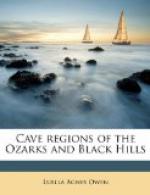A break in the description is made here for the purpose of inserting a description, written at the author’s request, by Mr. E.L. McDonald. He was generally our special guide. He has chosen to describe the route taken by the majority of visitors and therefore the balance of my observations within those limits are omitted.
All who are familiar with those passages and chambers will observe while reading the next chapter that no imaginary attractions are added to the existing facts, but many interesting minor points are missing.
Only such changes are made as were agreed to as the condition on which he would attempt a piece of work so at variance with his usual occupations.
FOOTNOTES:
[4] U.S. Geological Survey. Geology of the Black Hills. Henry Newton, p. 138.
CHAPTER X.
Wind cave continued.
THE FAIR GROUNDS ROUTE.
“At 9:30 in the morning the train bringing health-seekers and tourists arrives at Hot Springs, a beautiful little city nestled in the southernmost foot-hills of the world-reputed Black Hills of South Dakota. The choice of a hotel is soon made, and when located, the new-comers observe the other guests and acquaint themselves with the attractions of the resort. Probably during the day they are approached by the solicitor of the wonderful Wind Cave, who explains that the best way to reach the cave is by means of the coach and four seen at the hotel in the morning, and arrangements are made for the following day. The next morning, seated in the tally-ho coach with strangers who are soon acquaintances, you start on a beautiful twelve-mile drive to one of nature’s most interesting sights.
“Immediately after leaving town you begin to admire the scenery and enjoy the cool, refreshing breezes, wafted from the mountains to the north, down the slopes to the arid plains.
“After climbing a gently sloping ‘hog-back’ for about eight miles, you are at the top of the divide and one thousand feet higher than Hot Springs, which may be seen on the left. Looking ahead you can see Harney Peak, the highest mountain in the Black Hills district; and on the right you see Buffalo Gap, through which the creek runs that heads at Min-ne-pa-juta Springs. The Indians used to drive buffalo through this gap, hence its name. A small but thriving little town to the eastward takes its name from this Buffalo Gap. From here you begin to go down a gentle and winding incline to the cave, which is reached all too soon.
“At the office you register and procure tickets, and then have from one-half to three-quarters of an hour in which to eat lunch or dine at the hotel. Then all congregate in the office, from whence the start is made, after every one has put on a cave cap, not a suit, as such is entirely unnecessary. The guide leads the way to the entrance of the cave which is separated from the office by some little distance, and is located in the bed of a long since dry run, which in former times has bared the carboniferous strata, and within this kind of rock the cave is found.




